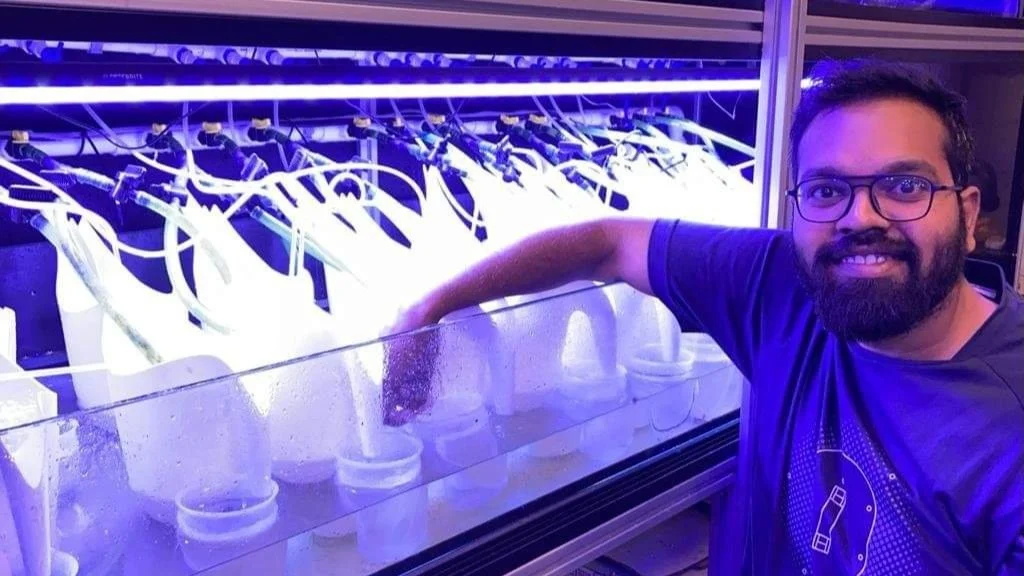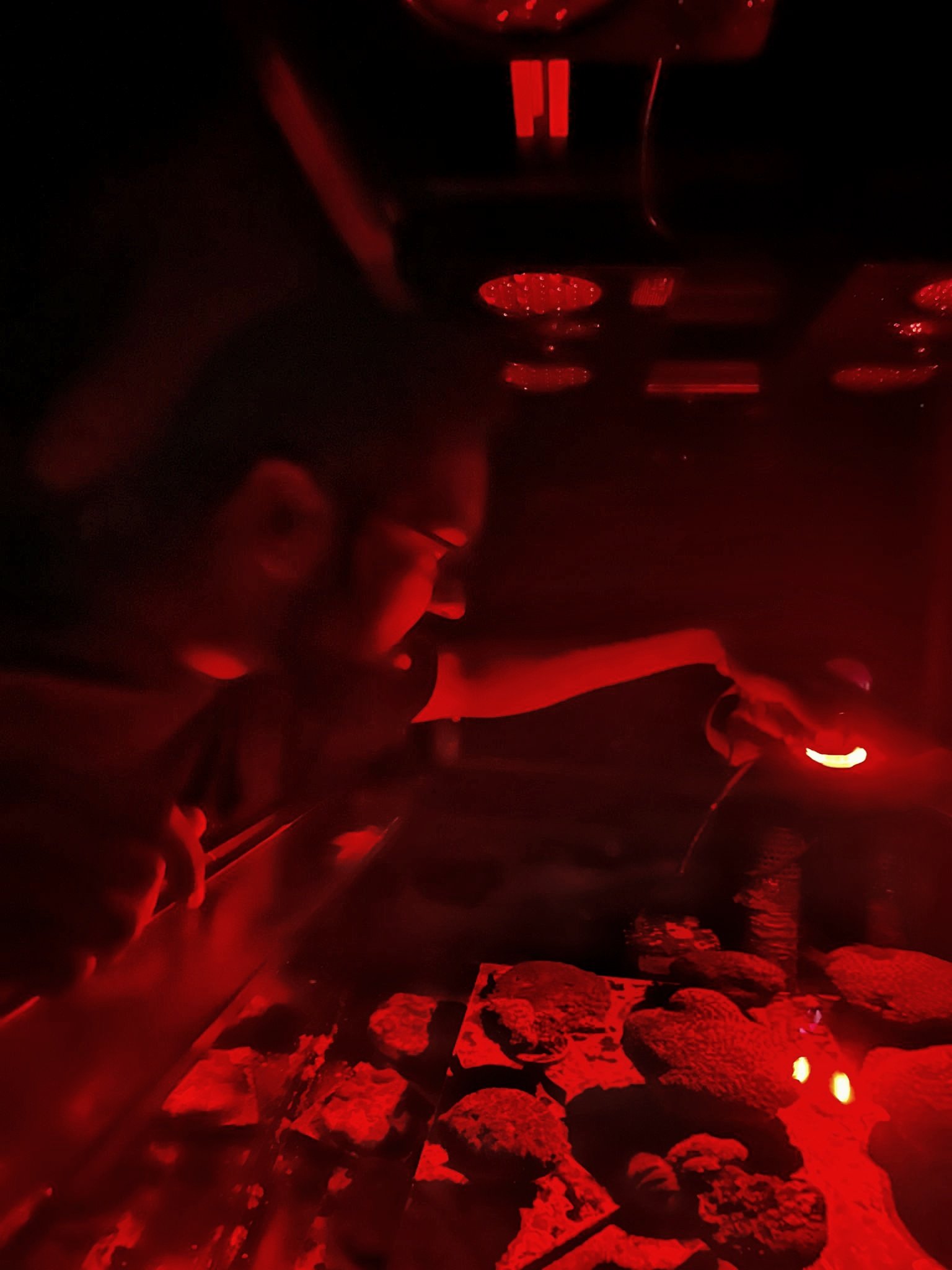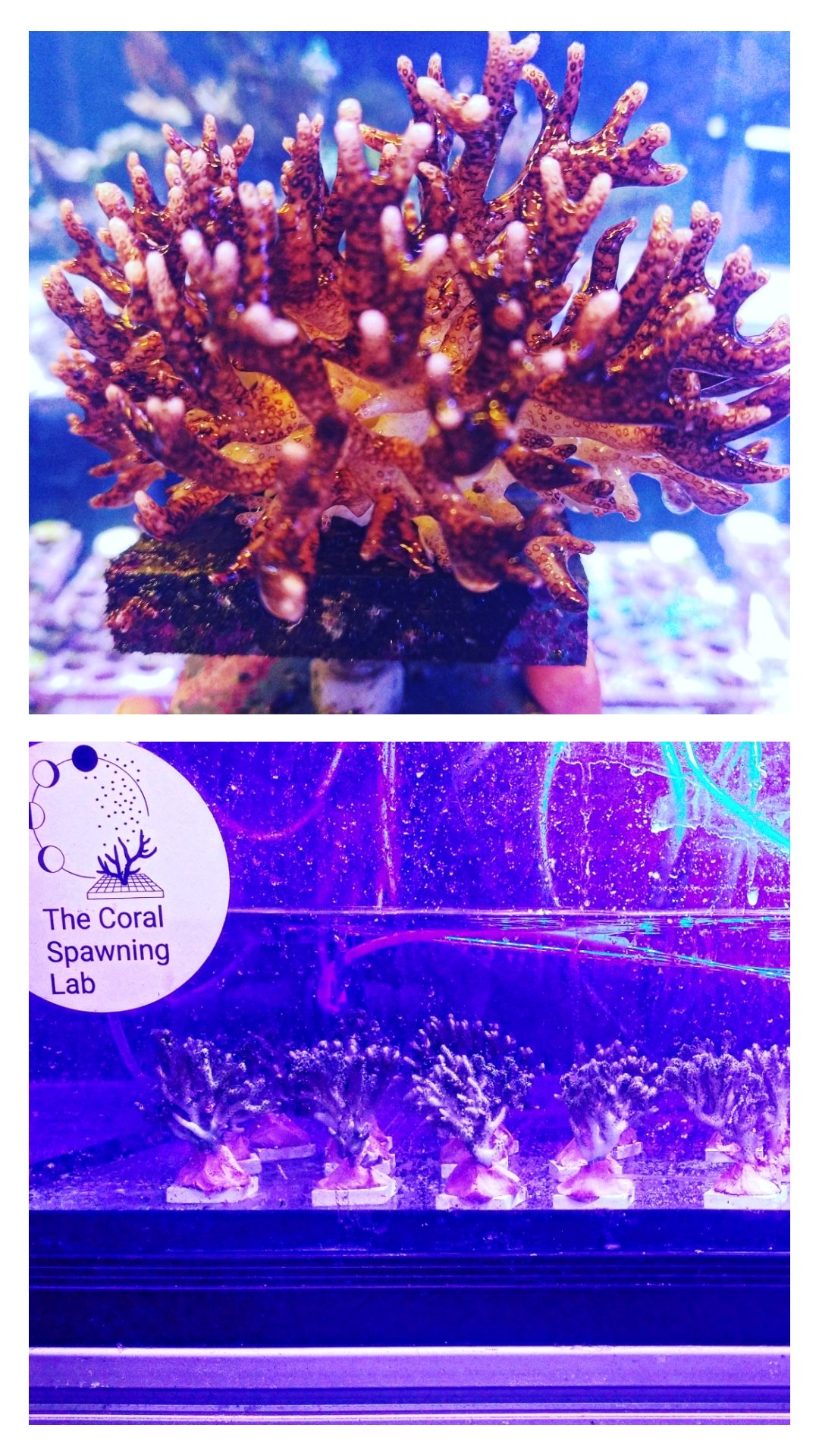Inlaks - Ravi Sankaran Intern 2021: Sharad Bayyana
Sharad Bayyana is a 2021 Inlaks - Ravi Sankaran Intern whose interest lies in coral husbandry and breeding. For his internship he had the opportunity to taking part in a project titled ‘Enhancing Reproductive Output in Brooding and Broadcast Spawning Scleractinian Corals Through Endocrine Manipulations’ under the guidance of Dr. Jamie Craggs at the Horniman Museum and Gardens in London.
This experience proved to be an opportunity to bridge the gap in coral reproductive biology research and hopes to bring advanced techniques for restoration efforts in the context of Indian reefs.
A Destination Towards Coral Restoration: Glances Through the Looking Glass
Ex-situ coral spawning observations in customized spawning tanks. Credits- Matt Drysdale
Corals are fascinating organisms that belong to the Phylum Cnidaria, a species closely related to the jellyfish. Among the diverse species of corals, the Scleractinians, commonly called hard or stony corals, live in a colony with hundreds of interconnected polyps of identical genetic makeup. They produce calcareous skeleton structures by gradually accumulating calcium carbonate from the water, making up the building blocks of coral reefs. Regarded as the tropical rainforests of the sea, they cover about one percent of the world's oceans in the tropical belt, harbouring a great diversity of marine organisms. They also protect coasts from natural disasters like tsunamis and cyclones as the large structures of reefs reduce the direct impact of wave energy on the coasts.
Over the past two decades, due to the change in climatic events, coral reefs have witnessed severe mass bleaching. It is further magnified due to anthropogenic activities and development in the coastal regions, diseases, pollution, and natural disasters like tsunamis.
With the current state of affairs, by 2050, the world’s reef faces the risk of local extinction. About 70-90 percent of existing coral cover is estimated to be lost, levying huge pressure on coastal communities to sustain their food resources and livelihood. It has been well established that scientific and social intervention is required to protect, conserve and restore coral reefs across the globe.
The conventional practices (conservation and restoration) of coral translocation and fragmentation require parts of existing colonies or entire colonies to be moved and planted out in another location (usually degraded reefs). It draws limitations as it is a labour-intensive practice and reduces genetic diversity. Apart from the conventional practices, the science of ex-situ (outside the natural environment) coral reproduction and culture are accelerating the means of coral propagation and restoration. Coral reproduction has been an elusive subject to study in a natural environment due to its complex relationship with a variety of physical parameters as well as the logistical limitations for an underwater study. Coral husbandry provides a wider scope in coral restoration as it allows one to understand, experiment, and manipulate coral physiology (particularly coral reproduction) in a confined environment.
Across the globe, artificial interventions through coral husbandry aid conservation and commercial prospects. Coral restoration through coral husbandry allows cross-breeding of genetically different populations of the same species, increasing genetic diversity within the population. The development of heat-resistant stony coral colonies to reduce mortality during high sea temperatures is one of the many examples of success with ex-situ interventions. Due to the deterioration of coral reef health, the natural genetic flow between the populations has decreased, making them susceptible to diseases and other physiological stress.
Larval rearing post ex-situ spawning and fertilization.
The collection of coral gametes during natural reproductive cycles in a natural environment and culturing/rearing them in artificial systems allow higher chances of intermixing in such conditions. Achieving success in coral spawning and reproduction in artificial conditions has further paved the way to overcome this ecological loss. Coral husbandry and artificial systems with advanced technology are opening up doors to develop more efficient methods to increase coral reproduction success and productivity in captivity. One such method is called ‘Micro Fragmentation’, where one adult coral colony of a species is fragmented into multiple individual colonies comprising few functional polyps. This practice increases the growth rate of each fragment, resulting in large colonies in a short period, thus providing more viable fragments to out-plant in the natural environment.
As part of my internship, funded and supported by Inlaks - Ravi Sankaran Internship, I worked in another frontier of coral reproductive research and coral husbandry under the guidance of Dr. Jamie Craggs and his team at the Horniman Museum and gardens, London.
Use of Micro-fragmentation method to produce multiple colonies from single parent colony
During my tenure in the museum, I was involved in an experimental project to understand the impact of synthetic supplements in boosting the reproductive fecundity of brooding and broadcasting type coral species. During my internship, I also had the opportunity to experience ex-situ coral spawning of Galaxia sp. from the Australian reef as part of the manipulative coral spawning experiments to increase the frequency of coral spawning in a year.
Unlike in India, where corals are protected and thus do not allow any commercial trade, many countries keep corals in aquariums as a hobby. Coral husbandry provides an alternative source of supply for the demand aquarium trade—thus reducing the pressure on the natural reef ecosystems to meet such demands. Conducting such experiments to boost the supply and productivity of commercial coral husbandry establishes direct and indirect impacts on coral conservation. Such commercial practices also assist in introducing genetic diversity in the coral populations.
Coral reefs in India are majorly distributed in four locations: Andaman and Nicobar Islands, Lakshadweep, Gulf of Mannar & Palk Bay, and Gulf of Kutch, with sporadic presence in the west along Maharashtra and Karnataka coast. The coral reefs support 28% of fisheries catch in India, supporting a large coastal community for their food resources and livelihood. Further, recreational and other tourism activities also contribute to the economy in the region.
With proposed coastal development activities clouded with global environmental anomalies in India, multiple means of coral conservation and restoration practices require attention. With diverse and geographically distinct coral reef ecosystems available across the Indian waters, coral husbandry and ex-situ interventions could assist in increasing the genetic diversity of the existing coral population and the production rate of coral fragments for restoration activities. Developing infrastructures for ex-situ coral propagation will open ways to understand the regional reproductive behaviour of the reef systems and conduct experimental studies in India.
Through this internship, I gained skills in primary coral husbandry practices, coral reproductive biology, and the need to study spawning patterns and population connectivity of coral reefs in India. This internship was a major step toward my long-term goal to plan conservation and restoration strategies based on scientific evidence and backing.
I would like to thank the Inlaks Shivdasani Foundation for their support in making this internship feasible and Dr. Jamie Craggs and the Horniman Museum and Gardens for providing me with the opportunity of joining their laboratory.
Top Image: Experimental set-up to study the effects of synthetic proteins on coral reproduction. Credits- Michelle Calvert
REFERENCES:
De, K., Venkataraman, K., & Ingole, B. S. (2017). Current status and scope of coral reef research in India: A bio-ecological perspective.
Raghuraman, R., Raghunathan, C., & Venkataraman, K. (2013). Present Status of Coral Reefs in India. Ecology and Conservation of Tropical Marine Faunal Communities, 351–379. doi:10.1007/978-3-642-38200-0_23
Nanajkar, M., De, K., & Ingole, B. (2019). Coral reef restoration-A way forward to offset the coastal development impacts on Indian coral reefs. Marine Pollution Bulletin, 149, 110504.
Hoegh-Guldberg, O., Kennedy, E.V., Beyer, H.L., McClennen, C., Possingham, H.P., 2018. Securing a long-term future for coral reefs. Trends Ecol. Evol. 33 (12), 936–944. https://doi.org/10.1016/J.TREE.2018.09.006doi:10.1016/J.TREE.2018.09.006.
Links:
https://www.unep.org/interactive/status-world-coral-reefs/
https://www.secore.org/site/home.html
https://www.horniman.ac.uk/project/project-coral/









